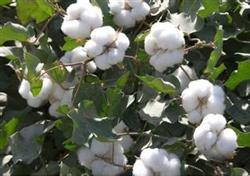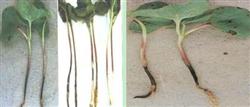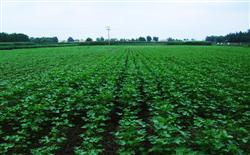Key measures for management of cotton boll opening period

The early maturity and early senescence of high-yield cotton at boll opening stage require that the lower part of cotton plant opens boll, the upper part continues to bloom, and the late bud is few. Strong growth of cotton, the top fruit branches flat stretch, fruit branches 20~30 cm long, there are 3~4 large buds. If the top fruit branches extend upward too long, buds cluster, flowers cut too late, it is prosperous and green late maturity performance. The leaf area coefficient (LAC) kept about 2.5 in the early stage of boll opening and decreased slowly. If the leaf area is too large, it is easy to cause closed field and delay boll opening; on the contrary, it is easy to cause premature senescence and reduce boll weight. The main contradictions in the production of boll opening stage are premature aging, late maturity and disease and pest damage. The environmental conditions for cotton to enter boll opening stage are sunny weather, sufficient sunshine, low air humidity and temperature above 20℃, which is conducive to cotton development and boll opening. However, due to severe autumn drought, the root system absorbs water and the photosynthesis of leaves is blocked, forcing the middle and lower bolls to open too early, and the upper young bolls stop growing, especially when the frost comes too early, the seeds and fibers cannot mature normally, resulting in yield reduction. Also some years, autumn rain continuous, due to low temperature, high humidity, less light caused by rotten bell. There are also late sowing, long growth period of varieties, excessive nitrogen application and other reasons resulting in late maturity. Cotton diseases and insect pests at boll opening stage are often explosive damage. Field management watering and waterlogging prevention in the opening period: in the middle and late August, when the soil moisture is lower than 60% of the field water capacity, water immediately, and serious drought can be irrigated until the middle and late September, and small water should be used to prevent flooding. Watering should not be too late, otherwise cotton will be greedy and late ripening. Pruning: late pruning can improve the ventilation and light transmission conditions of cotton field, reduce nutrient consumption, and be beneficial to increasing autumn peach, boll weight, early maturity and boll rot prevention. Generally, buds after August 5 and flowers after September 1 are invalid buds, which should be removed in time. Individual late vigorous growth, shade serious cotton fields, but also to beat old leaves, shear empty branches, push plants and ridge, anti-rotten bolls. Insect control and disease prevention: There are many sudden pests and diseases after cotton enters boll opening period, mainly four generations of cotton bollworm, which mainly harm summer cotton and late-maturing cotton; bridge-making insect and beet moth are sudden pests, the initial period is in the middle and late August, and the peak period of harm is September. The above pests should be inspected in time, and the control should be carried out at the peak incubation period, so as to eliminate them before the third instar. In addition, whitefly, red spider, thrips, autumn aphid, etc. should also be timely control. The disease is mainly caused by boll rot. For cotton fields with boll rot, in order to reduce the loss, the bolls with black spots can be picked as early as possible, soaked in 1% ethephon solution and then taken out for drying, so as to obtain better seed cotton. Due to various reasons, some cotton bolls cannot mature normally every year, especially summer sowing cotton, late-maturing cotton, interplanting cotton and saline-alkali soil cotton, which not only affects the yield, but also reduces the quality. Therefore, the corresponding ripening methods could accelerate the development of cotton bolls, make them open bolls earlier and increase the yield of flowers before frost. Ethephon ripening: suitable for high-yield cotton fields with more vigorous growth and more green bolls in the later stage. Use appropriate time to master the following three conditions: One is that the boll period of cotton plant periphery is more than 40 days, the other is 15~20 days before the frost period, and the third is that the daily maximum temperature is greater than 20℃. If used too early, bolls will bloom before ripening, which will reduce boll weight and cause yield reduction; if used too late, ethylene release will be slow due to low temperature, which will reduce ripening effect. Ethylene 150~200 ml per mu is sprayed evenly on 50~60 kg of water, and sprayed on the green bell as much as possible to improve the ripening effect. Spray again in case of rain 6 hours after spraying. Gramoxone ripening: suitable for late sowing and late ripening and intercropping cotton fields, early defoliation of cotton plants, conducive to field ventilation and light transmission. Spraying Gramoxone 50ml per mu on 30~ 40kg water, leaves can fall off in about 7 days, and the peak of boll opening can be reached after 8 days. When spraying, pay attention to protecting eyes and prevent spraying liquid medicine into eyes. Pulling and ripening: suitable for cotton, wheat, cotton and vegetable (rape) double cropping and direct seeding cotton field. The key is to master the time of pulling dry, the time is well mastered, both early stubble, but also does not affect cotton yield. In addition to the calculation of the boll period, the determination of the drying time is mainly based on the time when the temperature drops steadily to 15℃ over the years. Because the cotton fiber has stopped developing below 15℃, it will not affect the yield.
- Prev

Why does cotton have rotten roots?
Cotton may have anthracnose, symptoms: cottonseed can be damaged after germination and rot in the soil. The injured light, can also be unearthed, the seedling stem base produced purplish red stripes, and then expanded into a fusiform disease spot, slightly sunken, serious water loss vertical crack, and finally withered the seedlings. The masses call it rotting root disease. There are many disease spots on the cotyledons.
- Next

Key points of cotton management in July
July is the month of the fastest growth and the largest growth of cotton, and it is also the month of drastic weather changes, many disasters and serious diseases and insect pests. Most cotton fields enter the flowering stage in early July, and by the end of July, 90% of the vegetative and reproductive organs of cotton plants have grown.
Related
- The first cup of black tea in spring, the flavor and history of tea gardens in Kenya, Africa
- The computer can not only choose potatoes, but also grow tea rice. AI will grow winter oolong tea champion.
- It is not only the inflated tea bitten by insects, but also engraved with the four seasons tea in Beipu.
- The Oriental Beauty Tea Festival in Zhuxian County takes the stage at the weekend to experience the plus-size feast of oil tea.
- & quot; Oriental Beauty Tea & Exploration of Emei in Hsinchu, the hometown of quot;
- The new variety of strawberry "Tainong 1" dessert is the first choice with mellow aroma. Crimson gorgeous
- History of Tea in Taiwan: from Wild Inner Mountain to Export Tea Garden
- Two types of Taiwan Oriental Beauty Black Tea won the British three-Star Award for Childhood Tea Xiang Zhang Jiaqi changed from pilot to champion tea maker.
- Banana species and varieties: the planting history of Taiwan Xianren banana and dwarf banana is long, is banana disease resistant?
- Coffee planting Technology: Qianjie Coffee from Seedling to harvesting

